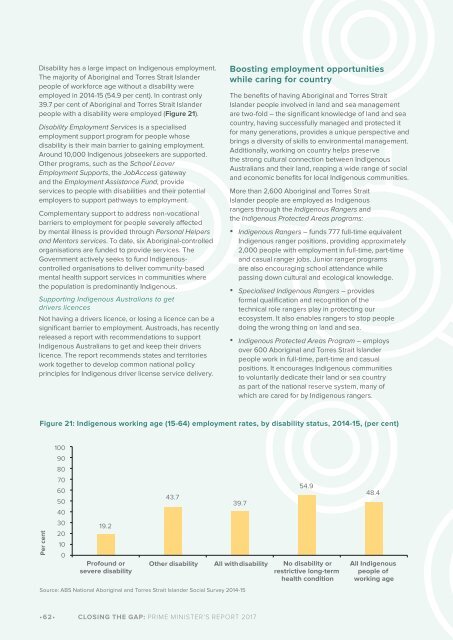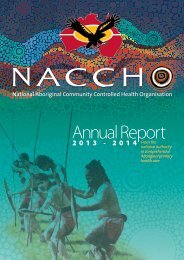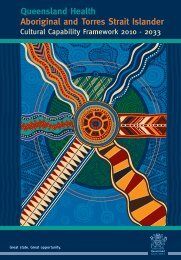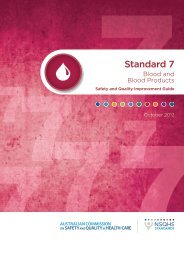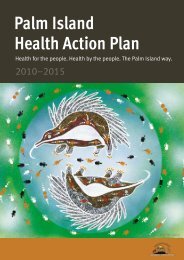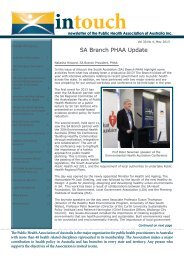CLOSING THE GAP
ctg-report-2017
ctg-report-2017
Create successful ePaper yourself
Turn your PDF publications into a flip-book with our unique Google optimized e-Paper software.
Disability has a large impact on Indigenous employment.<br />
The majority of Aboriginal and Torres Strait Islander<br />
people of workforce age without a disability were<br />
employed in 2014-15 (54.9 per cent). In contrast only<br />
39.7 per cent of Aboriginal and Torres Strait Islander<br />
people with a disability were employed (Figure 21).<br />
Disability Employment Services is a specialised<br />
employment support program for people whose<br />
disability is their main barrier to gaining employment.<br />
Around 10,000 Indigenous jobseekers are supported.<br />
Other programs, such as the School Leaver<br />
Employment Supports, the JobAccess gateway<br />
and the Employment Assistance Fund, provide<br />
services to people with disabilities and their potential<br />
employers to support pathways to employment.<br />
Complementary support to address non-vocational<br />
barriers to employment for people severely affected<br />
by mental illness is provided through Personal Helpers<br />
and Mentors services. To date, six Aboriginal-controlled<br />
organisations are funded to provide services. The<br />
Government actively seeks to fund Indigenouscontrolled<br />
organisations to deliver community-based<br />
mental health support services in communities where<br />
the population is predominantly Indigenous.<br />
Supporting Indigenous Australians to get<br />
drivers licences<br />
Not having a drivers licence, or losing a licence can be a<br />
significant barrier to employment. Austroads, has recently<br />
released a report with recommendations to support<br />
Indigenous Australians to get and keep their drivers<br />
licence. The report recommends states and territories<br />
work together to develop common national policy<br />
principles for Indigenous driver license service delivery.<br />
Boosting employment opportunities<br />
while caring for country<br />
The benefits of having Aboriginal and Torres Strait<br />
Islander people involved in land and sea management<br />
are two-fold – the significant knowledge of land and sea<br />
country, having successfully managed and protected it<br />
for many generations, provides a unique perspective and<br />
brings a diversity of skills to environmental management.<br />
Additionally, working on country helps preserve<br />
the strong cultural connection between Indigenous<br />
Australians and their land, reaping a wide range of social<br />
and economic benefits for local Indigenous communities.<br />
More than 2,600 Aboriginal and Torres Strait<br />
Islander people are employed as Indigenous<br />
rangers through the Indigenous Rangers and<br />
the Indigenous Protected Areas programs:<br />
• Indigenous Rangers – funds 777 full-time equivalent<br />
Indigenous ranger positions, providing approximately<br />
2,000 people with employment in full-time, part-time<br />
and casual ranger jobs. Junior ranger programs<br />
are also encouraging school attendance while<br />
passing down cultural and ecological knowledge.<br />
• Specialised Indigenous Rangers – provides<br />
formal qualification and recognition of the<br />
technical role rangers play in protecting our<br />
ecosystem. It also enables rangers to stop people<br />
doing the wrong thing on land and sea.<br />
• Indigenous Protected Areas Program – employs<br />
over 600 Aboriginal and Torres Strait Islander<br />
people work in full-time, part-time and casual<br />
positions. It encourages Indigenous communities<br />
to voluntarily dedicate their land or sea country<br />
as part of the national reserve system, many of<br />
which are cared for by Indigenous rangers.<br />
Figure 21: Indigenous working age (15-64) employment rates, by disability status, 2014-15, (per cent)<br />
Per cent<br />
100<br />
90<br />
80<br />
70<br />
60<br />
50<br />
40<br />
30<br />
20<br />
10<br />
0<br />
19.2<br />
Profound or<br />
severe disability<br />
43.7<br />
39.7<br />
54.9<br />
Other disability All withdisability No disability or<br />
restrictive long-term<br />
health condition<br />
Source: ABS National Aboriginal and Torres Strait Islander Social Survey 2014-15<br />
48.4<br />
All Indigenous<br />
people of<br />
working age<br />
•62• <strong>CLOSING</strong> <strong>THE</strong> <strong>GAP</strong>: PRIME MINISTER'S REPORT 2017


